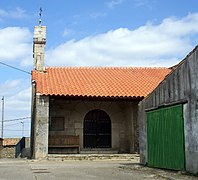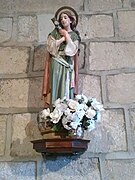Barceo
Barceo is a Spanish municipality and town in the province of Salamanca, in the autonomous community of Castilla y León. It is integrated into the Vitigudino region and the sub-region of La Ramajería. It belongs to the judicial district of Vitigudino.
Its municipal area is made up of the towns of Barceo and Barceíno (annejo), it occupies a total area of 21.13 km² and according to the demographic data collected in the municipal register prepared by the INE in 2020, it has a population of 43 inhabitants.
Toponymy
In the XIII century Barceo and Barceíno were called Barteo and Bartillino. The diminutive -ino that Barceíno has, typical of the Asturian language, indicates that its settlers in the XII century came from other areas of the kingdom of León, being quite common in Leonese the existence of contiguous localities in which the name of one is a diminutive of the other as it happened in other Leonese localities (Almendra and Almendrina, Moral and Moralina, Carbajales and Carbajalinos, etc).
In the 17th century the two localities were cited as Barzeo and Barzeyno, a clear linguistic evolution that has gradually varying until giving rise to the current writing, Barceo and Barceíno.
History
The foundation of Barceo dates back to the Middle Ages, obeying the repopulations carried out by the kings of Leon in the Early Middle Ages. It was the lordship of the Order of Santiago to which it was linked by order of King Ferdinand II of León in the XII century, maintaining in the same until 1873 under the bishopric of León de Santiago, which framed the Leonese territories of said Order, passing then, with its dissolution by papal order, to form part of the Diocese of Ciudad Rodrigo.
In 1462, the King of the Crown of Castile, Enrique IV, handed over to his favorite Beltrán de la Cueva the mastership of the Order of Santiago with a count and hereditary character. Assuming the birth of Ledesma County, under the Alburquerque family, a noble title that is maintained today. In this way, Barceo, was attached to said county under the domain of the Counts of Ledesma.
With the creation of the current provinces in 1833, Barceo was integrated into the province of Salamanca, within the Leonesa Region. Finally, through the constitution of the current autonomous communities, the municipality was integrated in 1983 into that of Castile and Leon.
Demographics
| Graphic of demographic evolution of Barceo between 1900 and 2022 |
 |
Source: Spanish National Statistical Institute - Graphical development by Wikipedia. |
According to the National Statistics Institute, as of January 1, 2021, Barceo had a total population of 44 inhabitants, of whom 26 were men and 18 women. Of this number, 27 correspond to the town of Barceíno, of which 15 were men and 12 women, and 17 to Barceo, the capital of the municipality, of which 11 were men and 6 women. Regarding the year 2000, the census reflected 70 inhabitants, of which 38 were men and 32 women. Therefore, the loss of population in the municipality for the period 2000-2021 has been 26 inhabitants, a 37% decrease.
Administration and politics
The local corporation of Barceo formed in June 2019 is made up of three councilors from the PP party. The form of government of the town corresponds to an open council regime, being one of the few towns in Salamanca that today continues with this form of municipal organization.
Municipal elections
| Political party | 2019 | 2015 | 2011 | 2007 | 2003 | ||||||||||
|---|---|---|---|---|---|---|---|---|---|---|---|---|---|---|---|
| % | Votes | Councillors | % | Votes | Councillors | % | Votes | Councillors | % | Votes | Councillors | % | Votes | Councillors | |
| Popular Party (PP) | 100,00 | 26 | 3 | 89.29 | 25 | 3 | 83.78 | 31 | 3 | 82.35 | 28 | 1 | 86.49 | 32 | 1 |
| Spanish Socialist Workers Party (PSOE) | - | - | - | - | - | - | 5,41 | 2 | 0 | 2.94 | 1 | 0 | 2.70 | 1 | 0 |
| SI Coalition for Salamanca (SI) | - | - | - | - | - | - | 5,41 | 2 | 0 | - | - | - | - | - | - |
| Union of the Salmantino People (UPSa) | - | - | - | - | - | - | - | - | - | 11,76 | 4 | 0 | - | - | - |
Mayors
Neither the mayoress nor any of the Barceo councilors receive an economic benefit for their work as head of the town hall (2017).

Monuments
The town of Barceo is a good example to contemplate the traditional architecture typical of the Ramajera subregion. Thus, both its streets and houses show whoever walks through them the carved granite stone, the protagonist in the buildings of this area of Salamanca. In addition, the urban distribution of Barceo is a good example of the local organization of the region, this is: two main streets around which other secondary streets are born. The alleys and small squares show the life of yesterday (faithful testimonies of the culture and ethnographic heritage of the town). Undoubtedly, a sample of tradition and life for all visitors.
The town has significant buildings of great history and tradition such as its parish church of Santa María Magdalena or the Ethnographic Museum of Barceo.
Culture
Parties
The patron saint festivals of the two population centers that make up the municipality are:
- Barceo in honor of Santa Maria Magdalena, celebrated the second weekend of August. It corresponds to the summer parties.
- Barcene in honor of Saint Virgin of Fresno, celebrated the second weekend of May. And that corresponds to the winter holidays.
Contenido relacionado
Calvarrasa de Arriba
Politics and government of Saint Lucia
Franc (currency)








